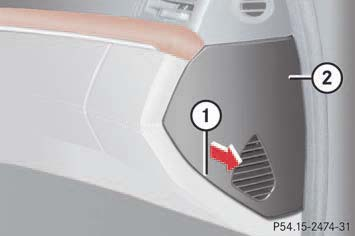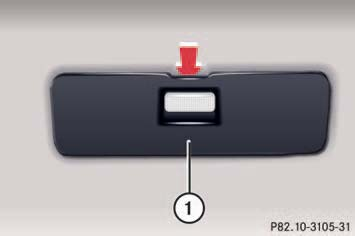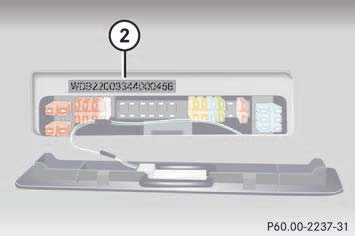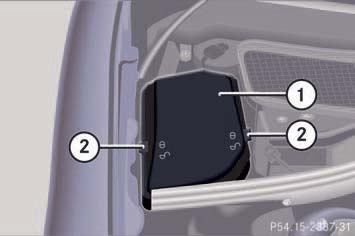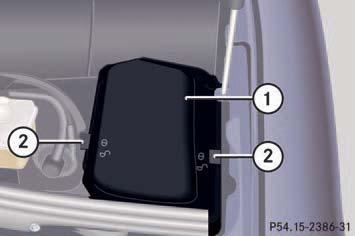Fuses
Location of Battery Fuses
http://www.youtube.com/watch?v=q0KFPZjErmw
Location of Fuse Boxes
- In Cabin; Dashboard Fuse Box (LHD on R or passenger side and RHD on L or passenger side)
Note: Images show fuse box location in left-hand drive vehicles.
- In Cabin; Under Right Rear Seat
- In Engine Compartment Fuse and Relay Boxes
There are fuse boxes located in the engine compartment on both the driver's and front passenger side in front of the firewall (dividing wall between engine compartment and passenger compartment).
Signal Acquation Modules
The left SAM in the engine compartment deals with all left front lights and the side light - except low beam (which comes from the right SAM), further rear air outlet illumination and glove compartment lock illumination. It also interacts directly with rotary light switch, the HCS switch, the steering column adjustment motor group (the motors via left front fuse and relay module), ESP, SPS and BAS control, with AIRMATIC with ADS control unit or ABC control unit and via right front fuse and relay box with refrigerant compressor.
The left SAM gets signal input from the left front brake pad contact sensor, refrigerant pressure sensor, refrigerant temperature sensor, outside temperature display temperature sensor, brake fluid indicator switch and parking brake indicator switch.
The right SAM in the engine compartment deals with all right front lights and the side light - except low beam (which comes from the left SAM), and also the lights in glove box, center console storage and eyeglass compartment, ashtray and footwell. It also handles heating and pumping for the windshield washer nozzle and washer nozzle hose and pumping water for the Headlamp Cleaning System; and the additional fan (radiator fan) for coolant, the fan for transmission oil cooler, and the circulation pump for the heating system delivery unit.
The right SAM gets signal input from the right front brake pad contact sensor, coolant level indicator with windshield washer fluid level indicator (both are in series!) and Anti-Theft Alarm [EDW] hood switch. Incoming and outgoing signals for the switches and controls for lights, pumps, heaters and so on in most cases are delivered via CAN from and to other controllers.
The rear SAM below the right rear seat cushion interacts directly with the trailer recognition control unit and with the ESP, SPS, BAS-controller. It communicates e.g. with the overhead control panel control unit via CAN. It also deals with all rear lights, closing the trunk and fasten seat belts indications; additionally it reads the tank level sensor, a tilt sensor (Anti-Theft Alarm inclination sensor), all 4 door contacts and the rear brakes sensors.
The relay for the fuel pump is placed near the rear SAM but normally it will get its signal from the ME. Only AMG versions have an extra controller for the fuel pump.
In addition to the fuses and relays, as mentioned, the SAMs have connections to the CAN busses. Some of these connections are located under the front seats of the car. Getting those connections wet due to water intrusion can also cause problems in equipment routed through the SAMs. And, the SAM under the back seat seems particularly affected when significant amounts of water intrude into the car.
Your car has three CAN busses. CAN B is the interior (or body) data bus; CAN C is the engine/chassis data bus; and CAN D is the diagnostics data bus. One can read possibly more that you wanted to know about CAN at http://www.mercedestechstore.com/pdf...2010-28-02.pdf
One can see that a problem may occur at the operating control; at the component being operated; somewhere in the CAN bus; or in the SAM itself (including fuses and relays). The first thing to check are fuses and relays; then, the component; then the operating control - and if the problem affects many components or switches, suspect the SAM. You can get a good idea if you have a SAM problem if you see malfunctions in multiple systems all operated via the same SAM. However, be sure to note Eric's cautionary note in post #13 below. SAMs don't fail often, and when they do it is frequently because they have been soaked in water.
One other thing that can cause random, repetitive error messages and malfunctions is a failing battery.
